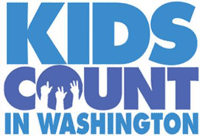Our children are growing up in an exciting and profound time. Conversations about income inequality, racial justice, gender equity, climate change, living-wage jobs, and family economic security—all essential issues for child well-being—are dominating our public debates. Growing knowledge and awareness of these issues is accompanied by reignited social movements that are gaining momentum thanks to new faces, old wisdom, savvy use of new technologies and communications, and a profound sense of urgency to change the course of our future.
The data in this report helps explain the tenor of these times. It shows an alarming share of children born in Washington state—four in ten—are growing up at risk of not having the most basic of needs met, like having enough food. A lack of living-wage jobs in communities throughout the state makes it difficult to meet basic needs on one full-time income, and sometimes that is not enough given the high costs of child care and housing. The lack of economic opportunity for many children affects all other areas of their well-being—including achievement in school, overall health, the likelihood of attending college, and their career prospects as adults. And structural racism—the way that policies, practices, and programs of different institutions combine and interact to sustain poorer outcomes among communities of color—undermines progress for children and the state as a whole.
The well-being of our children is a barometer for the future. In one short generation, they will be the parents, workers, volunteers, leaders, and change-makers determining the social and economic vitality of Washington state. If we want a better future for all of us, we need better results for kids now. Getting results means giving all kids what they need to reach their full potential. And it especially means investing in kids of color and those from families with low incomes, so they can overcome the barriers created by racism and poverty and can have equal opportunity to succeed.
This report features two recommendations for strategies to remove those barriers. First, we must remove the exclusionary practices that undergird much of our country’s public institutions—and replace them with measures designed to let kids of all backgrounds succeed. Second, we must focus our public investments on the success of the whole family, with the understanding that the well-being of children is inextricably tied to the well-being of their parents. In this year’s report, we establish three broad and ambitious goals for Washington kids, measured by eleven indicators of well-being (see below).
If we can make progress toward achieving these goals by ensuring these indicators are positive, child well-being across the board would soar, as would our state’s social and economic well-being. Research shows, for example, that babies who have high quality early life experiences at home with their parents or in the care of others have healthier brain development than babies living in more stressful environments. Children who have basic needs met are poised to do better in school than children who experience the instability of being hungry or not knowing where they are going to sleep at night. And equal access to high quality educational opportunities—from preschool to higher education—provides a foundation for lifelong learning so children can reach their full potential in life, which benefits all of us.
Goals & Indicators
Goal: All young children have a healthy start in life.
Indicators:
- Percentage of Low Birthweight Babies
- Percentage of Children from Birth to Age 5 Living in Families with Incomes over 200% of the Federal Poverty Line
- Cost & Availability of Child Care
Goal: All young children have their basic needs met.
Indicators:
- Percentage of Children with Health Coverage
- Percentage of Children who are Homeless
- Percentage of Children who are Food Insecure
- Ratio of Median Income to Cost-of-Living
Goal: All children have the opportunity to succeed in school and in life.
Indicators:
- Percentage of Children Ready for Kindergarten
- Percentage of Third Graders Meeting Reading Standards
- Percentage of Students Graduating High School on Time
- Percentage of Students Earning a Credential within Six Years of Graduating High School

